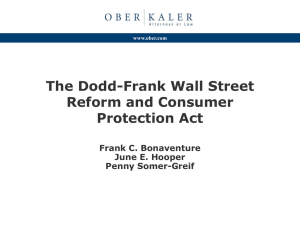Avoiding Antitrust Pitfalls in Hospital Acquisitions of
advertisement
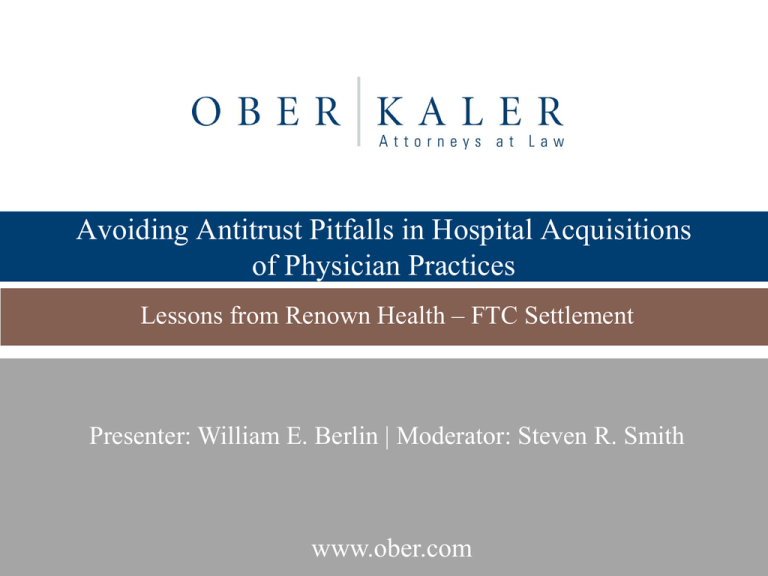
Avoiding Antitrust Pitfalls in Hospital Acquisitions of Physician Practices Lessons from Renown Health – FTC Settlement Presenter: William E. Berlin | Moderator: Steven R. Smith www.ober.com Meet Today’s Speakers William E. Berlin Principal, Ober|Kaler weberlin@ober.com | 202.326.5011 Presenter Steven R. Smith Principal, Ober|Kaler ssmith@ober.com | 202.326.5006 Moderator www.ober.com Webinar Housekeeping Slides are located in the upper left hand corner. Type your questions into the question window at any time. We will answer them at the end of the program, or follow-up individually afterwards if you provide your email address. A brief evaluation will be emailed to you after this program. www.ober.com Today’s Focus: Types of Affiliation and Parties Poll: Do you primarily work for or represent a hospital or physicians? 1.Hospital or health system 2.Physician group 3.Other www.ober.com Today’s Focus: Types of Affiliation and Parties Focus today is on hospital acquisition and employment of physicians Focus is on full mergers resulting in hospital ownership of assets and employment of physicians (vs. less-thanfully integrated JVs) But much of presentation applies equally to physician group mergers ACO Antitrust Policy Statement does not apply to fully-merged entities so do not address ACOs today Horizontal vs. vertical (or, here, both) mergers www.ober.com Increasing Trend in Hospital Acquisitions of Physician Groups Poll: Have you been involved in a hospital-physician affiliation of any kind? 1. Yes, in past two years 2. Yes, involved in ongoing affiliation currently 3. Not yet, but planning or contemplating an affiliation 4. No www.ober.com Increasing Trend in Hospital Acquisitions of Physician Groups Hospital-physician mergers (like hospital mergers) increased in past two years Impetus for increase in mergers Medicare reimbursement cuts Meeting health care reform Not only ACOs, but similar or other innovative quality and pricing mechanisms (e.g., ACE) Access to capital and market changes www.ober.com Full Merger vs. Less Integrated Affiliation Reasons hospitals acquire and employ physicians rather than less-integrated affiliation: Greater control and ability to implement pricing and productivity – align interests More straightforward than JV with myriad regulatory considerations (e.g., antitrust, Stark/AKB, etc.) Not necessarily directly profitable, but ultimately hope to retain/increase/capture patients (inpatient, outpatient, other physician specialties) www.ober.com Resulting Increase in Agency Enforcement Both FTC and state AGs have investigated and settled physician mergers in past 2 years None of these transactions were reportable under HSR threshholds, but still scrutinized All until Renown were either abandoned or resolved with conduct remedies Renown is first FTC settlement of a physician group acquisition, and only consent decree by any agency applying a “structural” remedy www.ober.com Physician Merger Challenges: Recent Enforcement Providence Health cardiologists FTC, hospital-physician, abandoned Urology of Central Pennsylvania (UCPA) PA AG, physician group, conduct remedies MaineHealth cardiologists Maine AG, hospital-physician, conduct remedies Renown Health cardiologists FTC & NAG, hospital physician, divestiture www.ober.com Physician Merger Challenges: Recent Enforcement Currently: California AG investigating Dignity Health, Scripps Health, Sharp HealthCare, Sutter Health FTC and Idaho AG investigating St. Luke’s Health System Multiple non-public FTC investigations www.ober.com Quick Overview of Applicable Law Clayton Act Section 7: applies to both prospective and consummated mergers (and JVs) that may “substantially lessen competition FTC/DOJ Horizontal Merger Guidelines Horizontal = Increased market power/coordination Vertical = Foreclosure/exclusion of competitors Sherman Act Section 1: Prohibits agreements between competitors that unreasonably restrain competition Can apply if parties not sufficiently integrated Also applies to certain pre-closing activities www.ober.com Renown Merger Background Renown Health is largest hospital system in Reno. Competitors include St.Mary’s and NNMC in Reno, and Carson-Tahoe Hospital in Carson City Acquired two largest cardiology groups in Reno – SNCA and RHP, about 15 MDs each. Few remaining MDs, so 97% market share initially in Reno MSA St.Marys recruited 3 MDs (and likely more but for settlement), reducing Renown’s share to 88% Employed MDs through contracts with noncompetes and other restrictions (typical in Reno, NV) Provisions in physician employment contracts to support any independent divested physicians (e.g., back office functions, office, contracting, etc.) www.ober.com Renown Merger Background “Community commitment” to maintain pre-merger coverage and referral patterns Payor commitment to maintain current rates and other contract terms – no renegotiation, and discussions of joint innovative products (e.g., bundled pricing) FTC/NAG requested parties to hold separate, but Renown closed, so agency investigation was effectively retrospective Impacted course of investigation and settlement www.ober.com Early/Pre-closing Do’s and Don’ts Do develop an efficiency/integration plan as the motivating force for the transaction, and then stick to it. Do engage payors early in the process to reassure and involve them (i.e., in merger efficiencies) - obtain buy-in Do reassure competitors (to the extent possible) and the community at large Public backlash can become political or agency opposition Do expedite the transactional process and close as soon as (and if) possible Do assess the antitrust risks (and retain an economist thru counsel) to anticipate and prepare for agency concerns www.ober.com Early/Pre-closing Do’s and Don’ts Don’t assume small non-reportable transaction will not be noticed by the FTC or AG Don’t create documents stating “bad intent” (e.g., to gain leverage, negotiating power) or referring to markets or competitions. Don’t wait until the transaction is well underway to generate an efficiency/integration plan – will appear pretextual Don’t “gun-jump” or share competitive information before the closing (e.g., during due diligence, integration planning) www.ober.com Renown FTC/NAG Investigation Clear that agencies would have serious concerns based simply on resulting market share in Reno, so investigation likely Defenses: Scope of geographic market includes Carson City Entry is easy, likely and sufficient via competing hospitals recruiting new cardiologists, had already begun Merger was “justified” by resulting efficiencies Regardless, no actual anticompetitive effects because of community and payor commitments www.ober.com Renown FTC/NAG Investigation Defenses (cont.) New and evolving market paradigm: vertically integrated hospital-physician health systems Intent: Trend away from independent practice to hospital employment nationwide Impact: Traditional enforcement tools too static, not useful/relevant in evolving hospital-physician integrated markets (e.g., market definition, concentration) FTC and NAG nontheless indicated they would challenge Despite actual entry by St. Mary’s, no price effect www.ober.com Investigation Do’s and Don’ts Do cooperate and maintain rapport and transparency with the agencies Be vigilant for openings to resolve agency concerns and thus the investigation Don’t neglect the AG Do continue to prepare your case on the substantive merits Otherwise there is no “Plan B” and no settlement leverage, and the agencies can and will call your bluff Key defense: identify rival hospital who can and will sponsor “entry” by recruiting new physicians Or if no noncompetes or other restrictions, even employed physicians can freely switch to rival so market share irrelevant www.ober.com Renown Settlement Complicated (and initially motivated) by dispute and litigation with first of acquired physician groups. Difficulty – determining how many physicians to divest and which ones (subspecialty, age, productivity) Noncompetes were complicating factor, but ultimate “solution” as mechanism for “testing the water” www.ober.com Renown Settlement Provisions Suspend noncompetes for 60 days to allow MDs to negotiate employment (or independent support) Standard for “acceptable terminations”: MD’s intent practice in Reno/Sparks for at least one year (Renown not guarantor) Threshholds: as few as 6 (75% residual market share) and no more than 10 (66% market share) Renown not required to terminate any (if less than 6 volunteer, N/Cs remain suspended) But Renown may affirmatively terminate MDs www.ober.com Renown Settlement Provisions Carve-outs permitting Renown to limit provider panels with payors or ACOs, excluding divested MDs from provider networks and paid positions or reading panels Support for divested physicians (independent) incorporated into consent decree Only ongoing requirements are compliance reporting and notice for new cardiology acquisitions Overall – flexible process with defined time period which allows Renown to resolve investigation, implement merger efficiencies going forward, and avoid operating under government oversight (limited) No more MDs divested than market can support www.ober.com Conduct vs. Structural Remedies What is a conduct remedy? What is a structural remedy? Conduct remedies potentially more restrictive than structural relief Urology of Central Pennsylvania (UCPA) – curtails bargaining power with payors: arbitrate contracting impasses, refer outside of UCPA MaineHealth – freezes premerger status quo: restricts pricing/contracting with payors, MD compensation, network composition www.ober.com Settlement Do’s and Don’ts Don’t “settle” for conduct remedies, advocate for a structural fix, where one is feasible Key to formulating a structural remedy is the presence of rival hospital(s) to employ and with capacity to absorb divested physicians Do negotiate forcefully, continuing to use substantive legal and economic arguments to support position Each transaction presents unique problems, but also unique solutions Insist on consistency/uniformity between FTC and AG terms Do follow the rules – the terms of the settlement – once you have agreed to them Penalties for compliance violation are potentially very significant (e.g., fines, civil penalty, injunctive relief) Don’t break the rules… www.ober.com Bottom Line It is possible to resolve an agency investigation/challenge and still preserve the merger's integrity and benefits Requires perseverance Not for the risk averse In the end, must weigh the benefits against the costs (perhaps literally in $$) www.ober.com Questions? Contact us. William E. Berlin Principal, Ober|Kaler weberlin@ober.com | 202.326.5011 Presenter Steven R. Smith Principal, Ober|Kaler ssmith@ober.com | 202.326.5006 Moderator www.ober.com
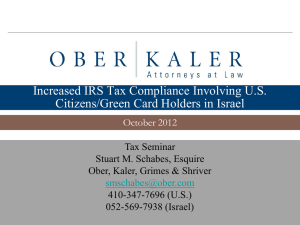

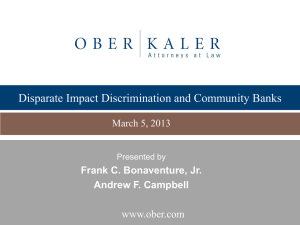

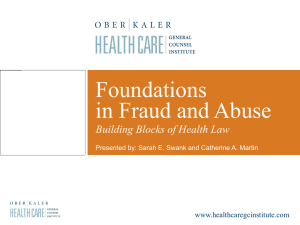

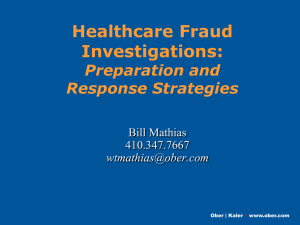
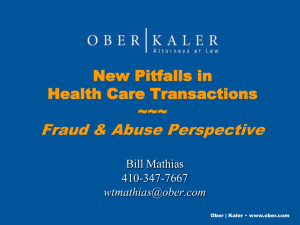

![Slides []](http://s2.studylib.net/store/data/005557570_1-9277c4d31d488a83343719e018f1550a-300x300.png)
